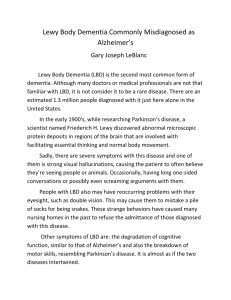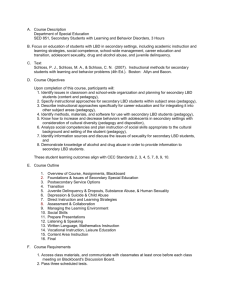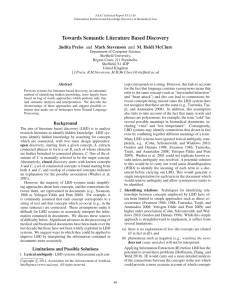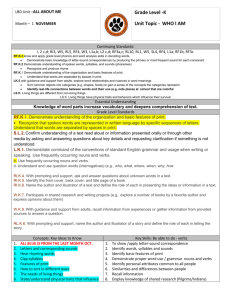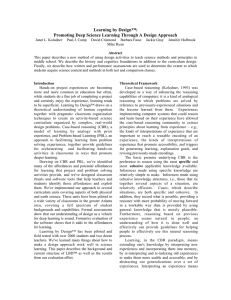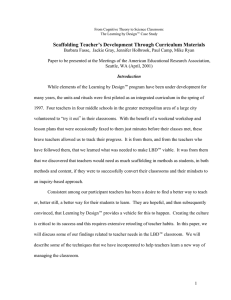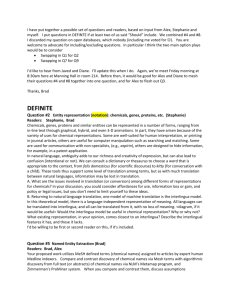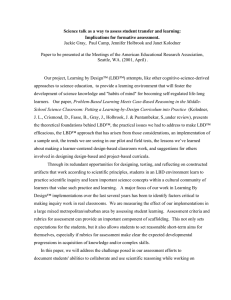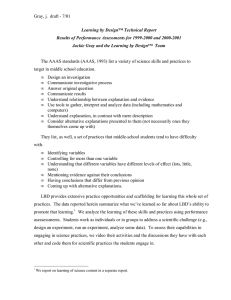Vragen voor tentamen Protein Engineering (8S080)
advertisement
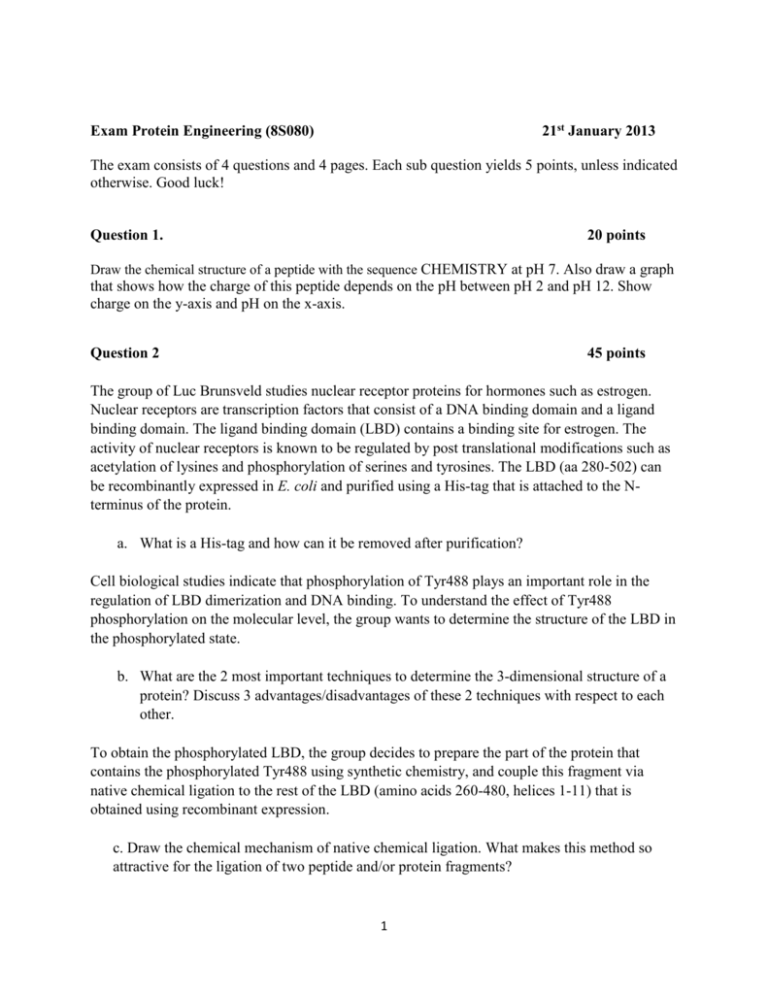
21st January 2013 Exam Protein Engineering (8S080) The exam consists of 4 questions and 4 pages. Each sub question yields 5 points, unless indicated otherwise. Good luck! Question 1. 20 points Draw the chemical structure of a peptide with the sequence CHEMISTRY at pH 7. Also draw a graph that shows how the charge of this peptide depends on the pH between pH 2 and pH 12. Show charge on the y-axis and pH on the x-axis. Question 2 45 points The group of Luc Brunsveld studies nuclear receptor proteins for hormones such as estrogen. Nuclear receptors are transcription factors that consist of a DNA binding domain and a ligand binding domain. The ligand binding domain (LBD) contains a binding site for estrogen. The activity of nuclear receptors is known to be regulated by post translational modifications such as acetylation of lysines and phosphorylation of serines and tyrosines. The LBD (aa 280-502) can be recombinantly expressed in E. coli and purified using a His-tag that is attached to the Nterminus of the protein. a. What is a His-tag and how can it be removed after purification? Cell biological studies indicate that phosphorylation of Tyr488 plays an important role in the regulation of LBD dimerization and DNA binding. To understand the effect of Tyr488 phosphorylation on the molecular level, the group wants to determine the structure of the LBD in the phosphorylated state. b. What are the 2 most important techniques to determine the 3-dimensional structure of a protein? Discuss 3 advantages/disadvantages of these 2 techniques with respect to each other. To obtain the phosphorylated LBD, the group decides to prepare the part of the protein that contains the phosphorylated Tyr488 using synthetic chemistry, and couple this fragment via native chemical ligation to the rest of the LBD (amino acids 260-480, helices 1-11) that is obtained using recombinant expression. c. Draw the chemical mechanism of native chemical ligation. What makes this method so attractive for the ligation of two peptide and/or protein fragments? 1 The part of the protein that is made using recombinant protein expression (amino acids 260-480) is expressed as a fusion protein with an intein domain and a chitin binding domain. d. Explain the function of each of these two domains. Illustrate your answer by providing a scheme that explains the different steps in the purification of this LBD fragment. The C-terminal part of the LBD (helix 12, amino acids 481-502) that contains Tyr488 is prepared with Solid-Phase Peptide Synthesis using Fmoc chemistry. e. Explain in detail how one would synthesize this peptide (NH2CKNVVPVpYDLLLEMLNAHVLRG-CO2H) using Fmoc SPPS. (10 points). Figure 1 shows two ESI-MS spectra, one of the recombinant protein fragment (aa 260-480), and one of the protein after native chemical ligation to the phosphorylated peptide. f. Calculate for each of the spectra the molecular weight. Which spectrum belongs to the ligation product? (10 points). 1727.7 1842.8 1680.0 1799.9 1400.2 1482.5 1575.1 B) 1382.4 1455.1 1535.9 1626.1 A) After establishing using ESI-MS that the semi-synthetic protein has the expected molecular weight, the next question is whether the semi-synthetic protein is correctly folded. g. Explain what CD spectroscopy is and how it can be used to establish the correct folding of the semi-synthetic protein. How can CD spectroscopy be used to compare the 2 thermodynamic stabilities of the different LBD domain forms (native LBD, semi-synthetic LBD in phosphorylated and non-phosporylated forms)? Question 3 30 points Dandruff is caused by a yeast (M. furfur) that lives on the skin. Unilever is a major manufacturer of shampoos and is therefore interested to develop new ingredients for the their anti-dandruff shampoos that would target specifically this type of yeast, without affecting other microorganisms living on the skin. One attractive possibility would be to develop M. furfur specific antibodies. a. What is the classical method to obtain monoclonal antibodies?. Classical monoclonal antibodies are not very attractive for commercial application in shampoo, because these antibodies can only be produced in mammalian cell lines. Unilever therefore decides to use llamas to raise antibodies against M. furfur b. What is the advantage of immunizing llamas instead of e.g. mice or rabbits? Discuss also the potential advantage of using the llama system for the development of antibody fragments that can be recombinantly expressed in E. coli. Unilever obtained several M. furfur-specific antibody fragments that express well in E. coli. Unfortunately the proteins are found to be unstable in the presence of shampoo. c. Explain how shampoo could decrease the thermodynamic stability of these antibody fragments (and proteins in general). d. Describe 3 rational design strategies to increase the stability of these antibody fragments.. e. Unilever decides to use directed evolution to further increase the stability of these proteins in their shampoo formulations, without decreasing the binding affinity and specificity for M. furfur. What directed-evolution method would you advise them to use in this case and why? Explain in detail how this methods works and one would apply this method in this case. (10 points). Question 4 5 points Chaperones en chaperonines are helper proteins that assist in the folding of newly synthesized proteins in the cell. Describe two ways in which these proteins can facilitate the folding of many different proteins. 3 Amino acid 1-letter code A = alanine C = cysteine D = aspertate E = glutamate F = phenylalanine G = glycine H = histidine I = isoleucine K = lysine L = leucine M = methionine N = asperagine P = proline Q = glutamine R = arginine S = serine T = threonine V = valine W = tryptophan Y = tyrosine 4

